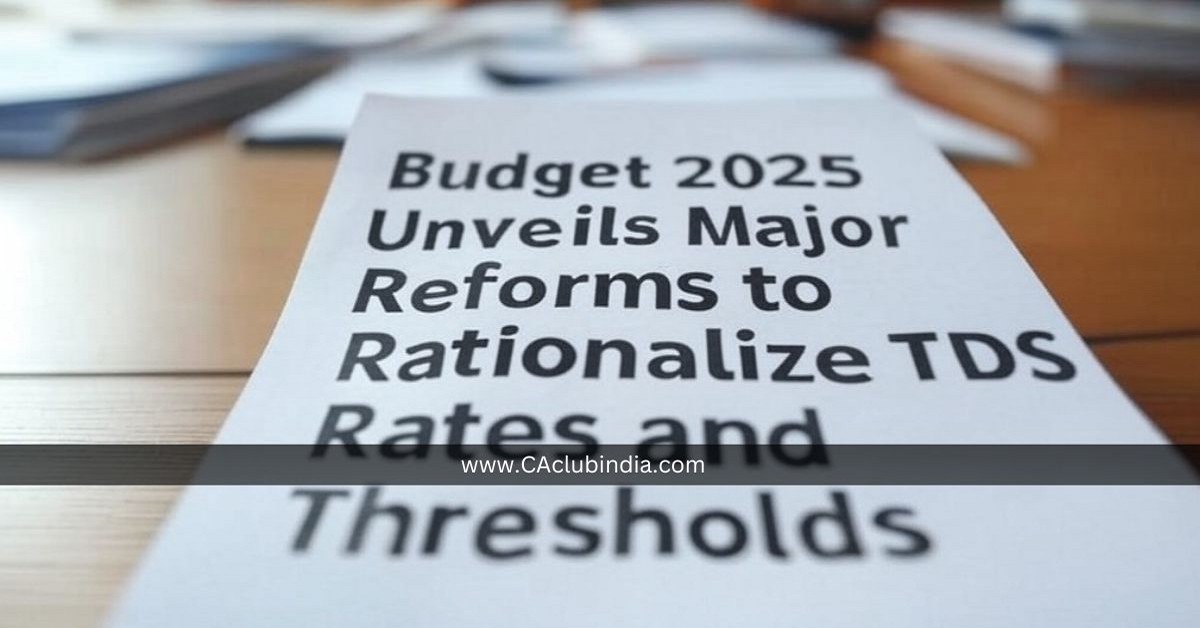In a decisive move to simplify tax compliance and boost the ease of doing business, the government has announced sweeping amendments to the Tax Deducted at Source (TDS) provisions. The proposed reforms aim to rationalize various TDS rates and increase threshold limits, thereby reducing administrative burdens for taxpayers and financial institutions alike.

Key Highlights of the TDS Reforms
1. TDS Rate Reduction for Section 194LBC
- Current Provision: Under Section 194LBC of the Income Tax Act, payments made by securitisation trusts to resident investors attract TDS at 25% for individuals/HUDs and 30% for other entities.
- Proposed Change: The government now proposes a significant reduction in the TDS rate under this section to 10%, reflecting the well-regulated nature of the sector.
- Effective Date: These changes will come into force from April 1, 2025.
2. Rationalization of TDS Thresholds Across Various Sections
To streamline TDS compliance, the government is revising thresholds for several key sections of the Act. Some of the notable changes include:
-
Section 193 (Interest on Securities):
- Current: No threshold
- Proposed: TDS to be deducted only when the aggregate interest exceeds Rs. 10,000 per financial year.
-
Section 194A (Interest Other Than on Securities):
- Banking Institutions & Cooperative Societies:
- Current: Rs. 40,000 (non-senior citizens) and Rs. 50,000 (senior citizens)
- Proposed: Increase to Rs. 50,000 and Rs. 1,00,000 respectively.
- Other Cases: Threshold increased from Rs. 5,000 to Rs. 10,000.
- Banking Institutions & Cooperative Societies:
-
Section 194 (Dividend Payments):
- Current: No TDS if the dividend amount does not exceed Rs. 5,000 per year for individuals.
- Proposed: Increase this threshold to Rs. 10,000.
-
Other Sections:
Amendments include increases in threshold limits for:- Winnings from lotteries and horse races (Sections 194B and 194BB) – moving from an aggregate condition to a per-transaction basis.
- Insurance commission (Section 194D), commission on lottery tickets (Section 194G), and brokerage (Section 194H) – thresholds to be raised from Rs. 15,000 to Rs. 20,000.
- Rent payments (Section 194-I) – shifting from a financial year threshold of Rs. 2,40,000 to a monthly threshold of Rs. 50,000.
- Fees for professional or technical services (Section 194J) – threshold increased from Rs. 30,000 to Rs. 50,000.
- Income from mutual funds (Section 194K) – threshold raised from Rs. 5,000 to Rs. 10,000.
- Payment of compensation on compulsory acquisition of property (Section 194LA) – threshold increased from Rs. 2,50,000 to Rs. 5,00,000.
All these adjustments are slated to take effect from April 1, 2025, offering immediate relief and operational ease for taxpayers.
3. Clarification on the Definition of "Forest Produce"
- Current Scenario: Ambiguities in the definition of “forest produce” have led to compliance challenges, particularly concerning the collection of Tax Collected at Source (TCS) at 2.5% on certain goods.
- Proposed Amendment: The government proposes to adopt the definition of “forest produce” as per the relevant State Acts or the Indian Forest Act, 1927. Moreover, TCS will apply only to forest produce obtained under a forest lease, excluding timber sourced by other means and tendu leaves.
- Effective Date: This clarification and the related TCS rate adjustments will also be effective from April 1, 2025.
Implications for Businesses and Taxpayers
Experts believe these reforms are a welcome move towards modernizing India’s tax framework. The increased thresholds and reduced TDS rates are expected to:
- Enhance Cash Flow: By reducing frequent TDS deductions on smaller transactions.
- Simplify Compliance: Fewer transactions will now fall under the TDS purview, easing administrative processes.
- Promote Transparency: Clear definitions and revised thresholds contribute to a more predictable and business-friendly tax environment.
"These reforms signal a significant step forward in reducing the compliance burden on businesses while ensuring that the tax system remains robust and transparent," commented a leading tax consultant.
Conclusion
The government's proposal to rationalize TDS rates and thresholds marks a transformative step in tax administration. By implementing these changes from April 1, 2025, authorities aim to foster a more streamlined, efficient, and investor-friendly taxation landscape. Stakeholders and industry experts will be closely watching the implementation process as these reforms promise to significantly impact the operational dynamics of businesses and financial institutions across India.
To know more in details, find the attached file





 CAclubindia
CAclubindia

